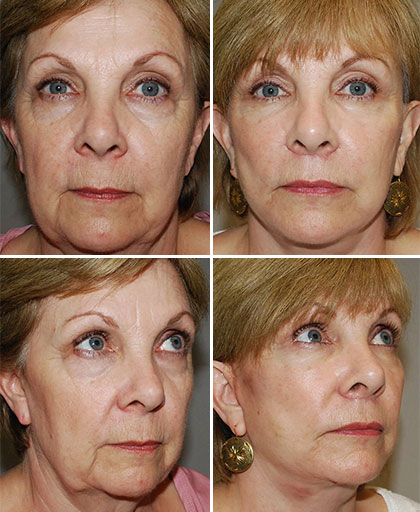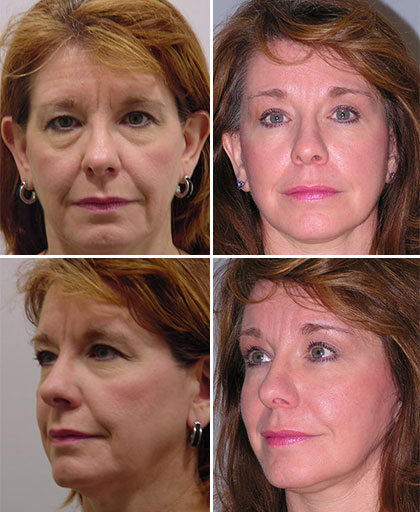Facelift in San Diego, CA
Non-surgical skin treatments may help delay lines and wrinkles from forming on the face and neck. Still, no one is immune to aging, and visible signs of aging will eventually become more difficult to reduce or eliminate. Regardless of their inevitability, wrinkles, sagging skin, and loss of facial volume can still be distressing. Luckily, you don’t have to live with it.
If you are afraid that a facelift will make you look artificial or leave you with a windswept appearance, know that advances in cosmetic surgery now allow qualified plastic surgeons to provide natural-looking and customizable facelift results that highlight your natural beauty.
Our reputable and board-certified plastic surgeons perform facelifts in San Diego, California, to help women and men regain a more youthful-appearing face and neck. The plastic surgeons at Coastal Plastic Surgery have the experience and skill you need to achieve the long-lasting facial rejuvenation outcome you desire.
What Can a Facelift Accomplish?
SmoothAway Facial Wrinkles
Collagen loss, sun damage, repeated muscle contractions, and environmental and lifestyle factors cause lines and deep creases to develop on your face and neck. Facelift surgery lifts and tightens skin and the underlying tissue to minimize or erase these wrinkles.
In the past, facelift procedures only tightened the skin, and the results left much to be desired. However, with today’s facelift techniques, both the skin and the underlying tissues are considered, allowing patients to maintain a natural but aesthetically improved look.
Rid Yourselfof Hanging Jowls
Another tell-tale sign of aging is the loosening skin around your jawline. As facial muscles in the midface weaken, they droop and form jowls. These pockets of skin and tissue obstruct the youthful, defined angles of the jaw and contribute to an aged appearance.
Facelift surgery tightens facial muscles and trims away the excess skin to restore smoother, younger-appearing jawline contours.
RestoreFacial Volume
While many of us would be happy to get rid of unwanted fat that develops with age, we are not so eager to say goodbye to the youthful fullness of our cheeks. Unfortunately, the fat pads under the cheek area lose volume, causing your face to look sunken and hollow.
Facelift surgery recontours and resuspends facial tissue, muscles, and fat, which helps to give the face a more contoured and fuller look. You can also include a fat transfer procedure or facial fillers for additional volume.
Say Goodbyeto Your Turkey Neck
Our surgeons will typically include a neck lift with your facelift to ensure a smooth transition between your face, jaw, chin, and neck because no one wants their loose neck skin to give away their age after having a facelift.
What Does Undergoing a Facelift Involve?
When you choose Coastal Plastic Surgeons for your San Diego facelift, we understand that no two facelift surgeries should be approached the same; instead, our surgeons create surgical plans that are as unique as you are.
Your San Diego Facelift Consultation
It all begins with an in-depth consultation, at which time our surgeon will listen carefully to your specific, age-related facial and neck concerns. They will review your medical history, examine your face and neck, then explain your options and what you can expect before, during, and after your surgery. You will also be provided with an accurate cost estimate.
We encourage you to make a list of questions to ask during your consultation and request to see examples of our facelift before and after results.
Call Coastal Plastic Surgeons in San Diego today at (858) 365-3558 to learn more about our San Diego facelift options. We also offer the GRBx™ facelift and neck lift for individuals with sagging facial and neck skin due to significant weight loss.
The Facelift Procedure
Facelift surgery is performed as an outpatient procedure, usually under general anesthesia, but a lighter general anesthetic or local anesthesia may be used depending on the amount of facial correction you desire.
While the exact techniques used for your facelift will depend on your needs, most of our facelift surgeries include the following steps:
- Incisions begin at the temples (within the hairline) and extend down around the ear. An additional incision may be made beneath the chin for your neck lift.
- Facial muscles and tissues are then recontoured to build up the cheek and chin areas while fatty deposits are removed.
- Finally, excess skin is trimmed, and the remaining is pulled taut and re-draped over your facial contours for a tighter but natural look. Our surgeon uses his skill to close incisions with stitches that leave little or no visible scarring.
As mentioned, neck lift surgery is almost always included with your facelift to reduce laxity and smooth vertical banding. Submental fullness, otherwise known as a double chin, can also be addressed during the neck lift portion of your procedure. Drains may be placed for fluid removal and to minimize swelling.
Can I Combine My Facelift With Other Cosmetic Facial Procedures?
Because facelift surgery targets the lower two-thirds of the face, we encourage you to add procedures to enhance the upper face and eyes for more comprehensive facial rejuvenation.
The following cosmetic procedures can be performed at the same time as your facelift surgery for even more dramatic results.
- Blepharoplasty (eyelid surgery) can eliminate upper eyelid hooding and reduce bags beneath the eyes.
- Brow lift surgery raises drooping brows and relaxes forehead lines.
- Otoplasty (cosmetic ear surgery) repositions protruding ears closer to the scalp.
You can also add one of these injectable treatments after you have recovered from surgery to address lines on the forehead and around the eyes or add more volume to the cheeks and lips:
- Injectable dermal fillers can restore lost volume to the cheeks and lips.
- BOTOX® Cosmetic reduces the appearance of crow’s feet, frown lines, and forehead lines.
Some Common Concerns About Facelift Surgery
How Much Does a Facelift Cost in San Diego?
The cost of your facelift surgery depends on several factors, including the extent of correction you desire, anesthesia fees, facility fees, surgical fees, and the costs of pre-surgical tests, post-surgical dressings, and medications.
You will be provided an estimate of your facelift costs at the end of your consultation. Coastal Plastic Surgeons offer financing options through Alphaeon® and CareCredit® to help their patients make their dream surgery a reality.
What Is Recovery From Facelift Surgery Like?
Facelift surgery manipulates facial skin and tissues; you can expect bruising and swelling after this procedure. Your surgeon will provide instructions on how to care for yourself and your incisions during your recovery. Following these instructions will allow you to heal quicker and help provide desirable results.
How Painful Is a Facelift?
Facelift surgery is typically performed under general anesthesia to prevent pain during or immediately following the procedure. You may experience mild to moderate discomfort after the anesthesia wears off. Your surgeon can prescribe pain medication, but many patients find over-the-counter medicines and cold compresses work well to control discomfort.
Most patients find the discomfort after facelift surgery to be quite bearable. Depending on how fast the swelling subsides, they can typically return to work or their normal activities within one to two weeks.
Avoid strenuous activities and exercise for four to six weeks or until your surgeon clears you.
Will I Have Scars After My Facelift?
The incision for facelift surgery is usually made along the hairline and around the ear. Our surgeons work diligently to make your incisions as small and inconspicuous as possible, but scarring may develop along these areas.
Scars are well hidden within the hairline and will fade over time. You can minimize your scars with proper wound care, protecting your incisions from sun exposure, and applying silicone strips or gel.
Facelift Results
View our gallery page for the procedures and treatments at Coastal Plastic Surgeons. At Coastal Plastic Surgeons, we believe in our methods and techniques for lasting results that can change your life. We offer procedures on everything from breast augmentation and body contouring, to facial aesthetics, hair restoration, and skin resurfacing. Every treatment is displayed here in our gallery.
Patient Testimonials
Facelift FAQ
Am I a candidate for a facelift?
Will people know I’ve had a facelift?
Is there a non-surgical alternative to a facelift?
Are there any potential long-term risks?
- Adverse reactions to anesthesia
- Infection
- Bleeding
- Blood clots
- Prolonged swelling
- Nerve injury or weakness
- Fluid accumulation
- Persistent pain
- Changes in skin sensation
- Poor wound healing
- Unfavorable scarring
- Hair loss at the incision sites
- Skin discoloration
- Facial asymmetry
How long does a facelift last?
Coastal Plastic Surgeons for Your San Diego Facelift
Choosing your surgical team is an instrumental part of your facelift experience. At Coastal Plastic Surgeons’ state-of-the-art facility, we offer advanced facial rejuvenation techniques and compassionate care. Please call us at (858) 365-3558 to learn more.
Our San Diego plastic surgeons are renowned in Southern California for their expertise in facial rejuvenation and have treated numerous facelift, neck lift, eyelid surgery, brow lift, and otoplasty patients.


